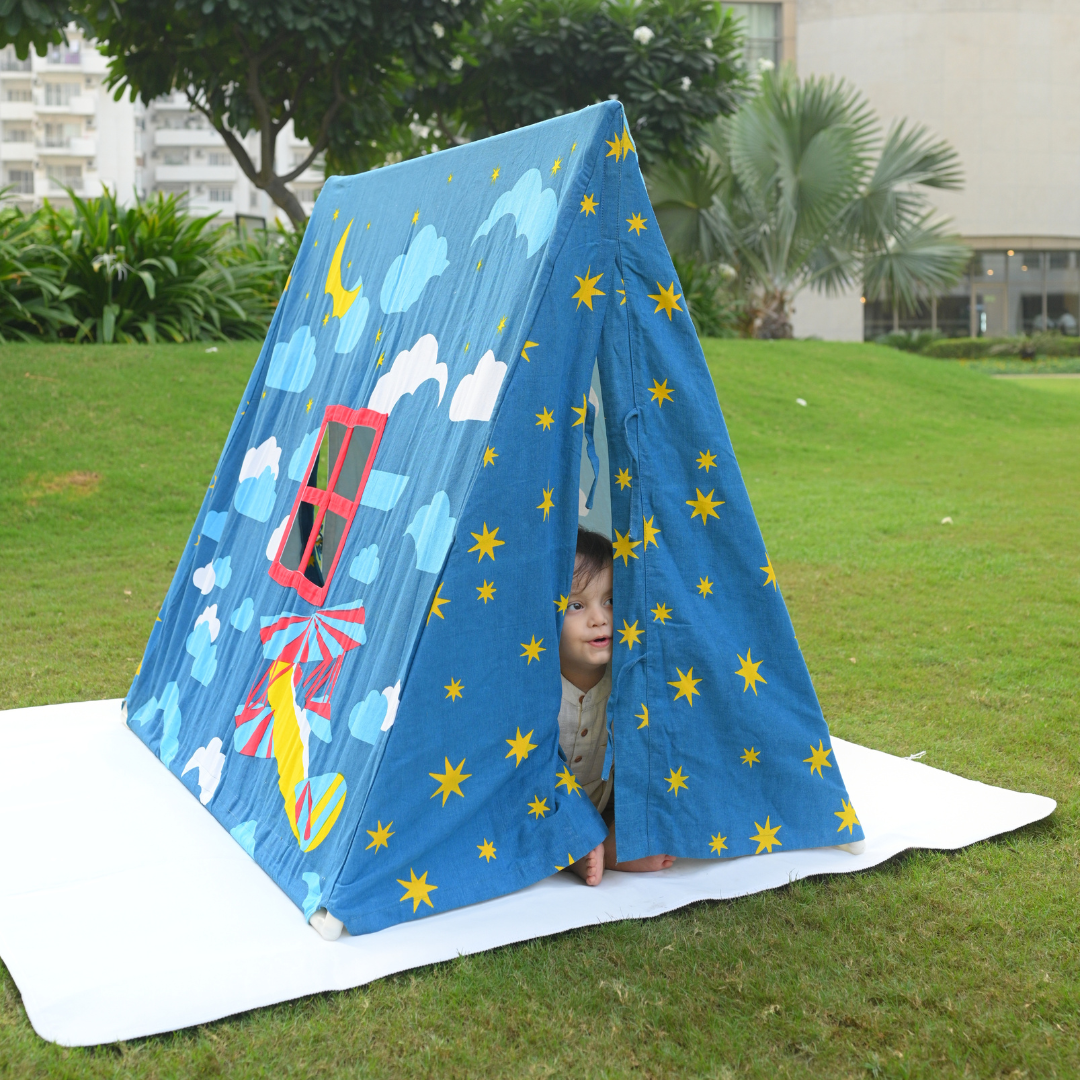As parents, we are always on the lookout for fun, safe, and educational ways to nurture our children’s growth. Amid the vast array of toys and gadgets, one surprisingly simple and magical item has been quietly making waves: the play tent. Beyond just being a cute hideaway or a cozy spot to curl up with a book, play tents hold a secret superpower—they are brilliant tools for sensory development. If you’ve never considered how such a charming little structure could boost your child’s sensory skills, sit tight because this might just transform how you view playtime.
The Magic of Sensory Development in Early Childhood
Before diving into the wonders of play tents, it’s helpful to understand sensory development’s role in a child’s early years. Sensory development involves the growth and refinement of the senses—sight, sound, touch, taste, and smell—alongside the vestibular (balance) and proprioceptive (body awareness) senses. These senses work together to help children interpret and react to the world around them.
For babies and toddlers, experiencing diverse sensory inputs is crucial for brain development. It influences everything from language acquisition and motor skills to emotional regulation and social interaction. Children naturally explore their environment to stimulate these senses. That’s where play tents step in—not just as toys but as immersive sensory environments.
Play Tents: More Than Just a Play Space
Play tents create a dedicated space that feels special and separate from the rest of the room or home environment. This separation is a subtle but powerful cue for a child’s brain. It says, “Here is a place to focus, imagine, and discover.” Whether it’s a teepee, a castle, or a simple dome, the structure provides a cozy nook that sparks curiosity and invites sensory exploration.
Imagine a brightly colored tent with soft fabric walls that children can touch and feel. The gentle rustle of fabric, the way the tent filters light creating shadows and patterns inside—all these subtle sensory experiences make the play tent a multi-sensory haven. It encourages children to engage their senses actively rather than passively.
Encouraging Tactile Exploration
One of the most obvious sensory benefits of a play tent is tactile stimulation. When children crawl inside, they encounter different textures—soft cotton, mesh windows, sometimes even added elements like faux fur rugs or cushions from brands like Happy Matty Store, known for their ultra-soft mats and bedding that perfectly complement play tents.
Touching the fabric walls, feeling the air movement when the tent flap sways, and the contrast between the hard floor outside and the cushioned interior provide rich tactile input. For toddlers, this tactile stimulation helps them develop fine motor skills and sensory processing abilities. The tent also becomes a space where children can experiment with cause and effect, such as feeling the tent move when they shake it or zip it open and closed.
A Visual Playground
Light plays a fascinating role inside play tents. The tent material often filters sunlight, creating an ever-changing pattern of light and shadow. This visual play can be soothing and stimulating at the same time. Children’s eyes follow the shifting light spots, helping develop visual tracking skills.
Moreover, the confined space of a play tent reduces visual distractions from the outside world. This concentration on a limited visual field helps children with focus and attention span—skills that are vital for learning. Some play tents even come with colorful panels or windows, adding layers of visual stimulation that encourage imaginative play and cognitive development.
Sound and Acoustics in the Tent World
It’s not just about what children see and touch. Sound inside a play tent changes too. The tent fabric absorbs outside noise and creates a soft, muffled environment. This acoustic difference gives kids a unique auditory experience. Whispering secrets inside a tent feels more intimate and exciting because the sound is contained.
This can be particularly beneficial for children who are sensitive to loud or overwhelming sounds. The play tent becomes a calming retreat, a place to escape from sensory overload and practice auditory processing in a controlled setting. Plus, playing with different sounds inside the tent—clapping, singing, or playing musical toys—helps kids develop their understanding of sound dynamics.
Promoting Vestibular and Proprioceptive Sensory Input
The vestibular system, which helps control balance and spatial orientation, and the proprioceptive system, which gives the brain information about body position and movement, are often overlooked when it comes to toys. However, play tents naturally encourage movements that stimulate these senses.
Getting in and out of the tent, crawling, sitting, or rocking inside provides proprioceptive input as children learn about their body’s position relative to the tent. If the tent is placed on a soft mat or cushioned surface, such as those offered by Happy Matty Store, it adds an extra layer of comfort and safety, encouraging even more movement and play.
Parents might notice their little ones rocking gently or swaying while inside the tent. This self-regulating movement is a healthy vestibular exercise that supports emotional regulation and coordination skills. The tent becomes a tiny sensory gym disguised as a cozy hideaway.
Fostering Imaginative and Social Play
Sensory development isn’t just about physical senses—it’s deeply connected to a child’s emotional and social growth. Play tents provide a perfect setting for imaginative play, which is a critical aspect of sensory and cognitive development.
Children can pretend the tent is a spaceship, a castle, a jungle hut, or a secret clubhouse. These scenarios require them to use all their senses—visualizing the setting, hearing imaginary sounds, feeling the fabric as “walls,” and sometimes even inventing smells or tastes. This rich sensory play fuels creativity and helps children develop problem-solving and language skills.
Socially, tents become gathering spots where siblings and friends can interact. Through cooperative play inside the confined space, children learn to share, negotiate, and communicate—all vital social-emotional skills that link back to sensory processing.
The Safety and Comfort Factor
An often overlooked but important aspect of sensory development is feeling safe and comfortable in the environment. Play tents offer a sense of enclosure and control that many children crave. This safe zone allows children to explore sensory inputs without feeling overwhelmed.
The materials used by trusted brands like Happy Matty Store are soft, breathable, and hypoallergenic, enhancing the comfort inside the tent. This attention to quality supports not only sensory exploration but also overall wellbeing. When children feel secure and comfortable, their brains are more open to learning and development.
Integrating Play Tents into Everyday Life
You might wonder how to make the most of a play tent for your child’s sensory growth. It’s easier than you think. Start by making the tent a regular part of playtime, not just a once-in-a-while novelty. Add soft mats or cushions inside to create a comfortable sensory zone. Incorporate sensory toys, like textured balls, soft blocks, or even musical instruments.
Rotate the setup occasionally to keep things fresh—change the lighting, add new textures, or use the tent outdoors for a different sensory environment. This kind of consistent but varied sensory input is exactly what developing brains need.
Parents also find that play tents offer a nice balance of independent play and guided interaction. You can join your child inside to read a story or sing songs, which enhances bonding and communication skills while keeping sensory stimulation gentle and enjoyable.
Why Happy Matty Store Play Tents Stand Out
When it comes to selecting a play tent, quality matters. The materials, safety standards, and complementary accessories all play a role in how beneficial the tent will be for sensory development. Happy Matty Store offers an impressive range of play tents that are thoughtfully designed with both fun and sensory benefits in mind.
Their tents often come paired with ultra-soft, absorbent mats and cushions that provide a luxurious sensory foundation. The fabrics are gentle on the skin, breathable, and easy to clean—perfect for busy parents and active kids. The vibrant yet soothing color palettes are carefully chosen to engage without overwhelming the senses.
What really sets Happy Matty apart is the attention to creating a multi-sensory experience. Their products are not just beautiful but functional, encouraging tactile, visual, auditory, and proprioceptive play. When you bring home a Happy Matty play tent, you’re giving your child a sensory sanctuary that grows with them.
The Long-Term Benefits for Your Child
While the immediate joy of play tents is obvious, the sensory benefits extend well beyond early childhood. Children who have rich sensory experiences tend to develop stronger cognitive skills, better emotional regulation, and enhanced social abilities. The sensory foundation built in those early years is like planting seeds for future learning and resilience.
Using a play tent as a sensory tool supports not only typical development but can also be especially helpful for children with sensory processing challenges or those on the autism spectrum. The controlled sensory environment can become a place to self-soothe, explore at their own pace, and build confidence.
Suggested Reading; Beyond Diapers: Why Baby Dry Sheets Are a Nursery Essential
Wrapping It Up: A Cozy Corner That Works Wonders
In a world full of flashy toys and digital distractions, sometimes the simplest things offer the richest rewards. Play tents, with their cozy walls and inviting spaces, are more than just charming hideaways. They are sensory development powerhouses that nurture your child’s senses through touch, sight, sound, balance, and imagination.
Incorporating a quality play tent from Happy Matty Store into your child’s play routine can provide a safe, comfortable, and stimulating environment that fosters exploration and learning. As you watch your little one crawl in, explore textures, follow dancing shadows, and dream up adventures, you’ll realize that the humble play tent is a tiny world of growth and discovery.
If you’re ready to give your child the gift of sensory-rich play in a cozy, stylish, and safe space, check out the wonderful collection at https://happymattystore.com/. Their carefully crafted play tents and complementary soft mats are designed to turn every day into a sensory adventure, making learning and play truly joyful for your little explorer.



